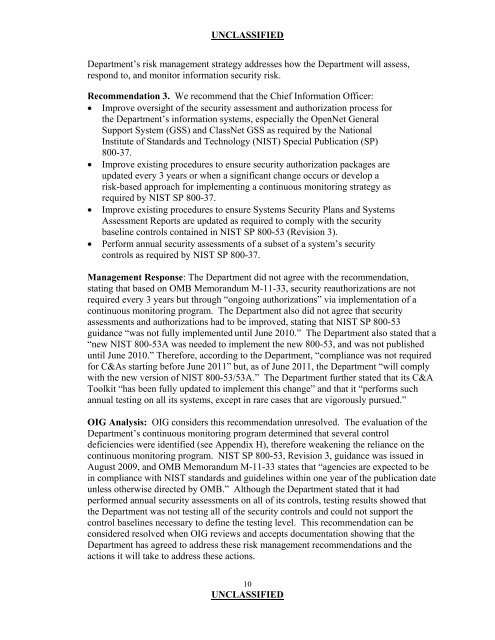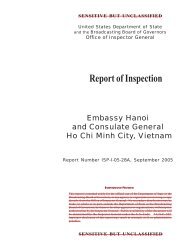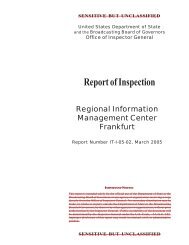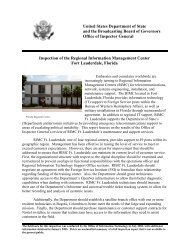Evaluation of Department of State Information Security Program ...
Evaluation of Department of State Information Security Program ...
Evaluation of Department of State Information Security Program ...
Create successful ePaper yourself
Turn your PDF publications into a flip-book with our unique Google optimized e-Paper software.
UNCLASSIFIED<br />
<strong>Department</strong>’s risk management strategy addresses how the <strong>Department</strong> will assess,<br />
respond to, and monitor information security risk.<br />
Recommendation 3. We recommend that the Chief <strong>Information</strong> Officer:<br />
� Improve oversight <strong>of</strong> the security assessment and authorization process for<br />
the <strong>Department</strong>’s information systems, especially the OpenNet General<br />
Support System (GSS) and ClassNet GSS as required by the National<br />
Institute <strong>of</strong> Standards and Technology (NIST) Special Publication (SP)<br />
800-37.<br />
� Improve existing procedures to ensure security authorization packages are<br />
updated every 3 years or when a significant change occurs or develop a<br />
risk-based approach for implementing a continuous monitoring strategy as<br />
required by NIST SP 800-37.<br />
� Improve existing procedures to ensure Systems <strong>Security</strong> Plans and Systems<br />
Assessment Reports are updated as required to comply with the security<br />
baseline controls contained in NIST SP 800-53 (Revision 3).<br />
� Perform annual security assessments <strong>of</strong> a subset <strong>of</strong> a system’s security<br />
controls as required by NIST SP 800-37.<br />
Management Response: The <strong>Department</strong> did not agree with the recommendation,<br />
stating that based on OMB Memorandum M-11-33, security reauthorizations are not<br />
required every 3 years but through “ongoing authorizations” via implementation <strong>of</strong> a<br />
continuous monitoring program. The <strong>Department</strong> also did not agree that security<br />
assessments and authorizations had to be improved, stating that NIST SP 800-53<br />
guidance “was not fully implemented until June 2010.” The <strong>Department</strong> also stated that a<br />
“new NIST 800-53A was needed to implement the new 800-53, and was not published<br />
until June 2010.” Therefore, according to the <strong>Department</strong>, “compliance was not required<br />
for C&As starting before June 2011” but, as <strong>of</strong> June 2011, the <strong>Department</strong> “will comply<br />
with the new version <strong>of</strong> NIST 800-53/53A.” The <strong>Department</strong> further stated that its C&A<br />
Toolkit “has been fully updated to implement this change” and that it “performs such<br />
annual testing on all its systems, except in rare cases that are vigorously pursued.”<br />
OIG Analysis: OIG considers this recommendation unresolved. The evaluation <strong>of</strong> the<br />
<strong>Department</strong>’s continuous monitoring program determined that several control<br />
deficiencies were identified (see Appendix H), therefore weakening the reliance on the<br />
continuous monitoring program. NIST SP 800-53, Revision 3, guidance was issued in<br />
August 2009, and OMB Memorandum M-11-33 states that “agencies are expected to be<br />
in compliance with NIST standards and guidelines within one year <strong>of</strong> the publication date<br />
unless otherwise directed by OMB.” Although the <strong>Department</strong> stated that it had<br />
performed annual security assessments on all <strong>of</strong> its controls, testing results showed that<br />
the <strong>Department</strong> was not testing all <strong>of</strong> the security controls and could not support the<br />
control baselines necessary to define the testing level. This recommendation can be<br />
considered resolved when OIG reviews and accepts documentation showing that the<br />
<strong>Department</strong> has agreed to address these risk management recommendations and the<br />
actions it will take to address these actions.<br />
10<br />
UNCLASSIFIED








